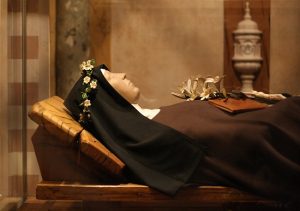Yeah…I know St. Patrick’s Day is coming up, but it’s about time we start recognizing that there are saints in many faith traditions AND that many of them are women. Yesterday’s focus was saints in the Hindu tradition. Today, it’s female saints in the Christian/Catholic tradition. While Joan of Arc and Mother Teresa are probably the most famous, here are a couple of others you might like to know about.

St. Francis, Sante Fe, NM [Wikimedia/Always dreamin
(public domain)]
Tekakwitha was an Algonquin-Mohawk woman born in the 1600’s. When a smallpox epidemic swept through her village, her tribe was decimated and her immediate family members died; Tekakwitha’s face was scarred and her eyesight was compromised. Jesuit missionaries were a regular presence in the Mohawk villages, and at age 19, Tekakwitha was baptized and given the name Kateri (the Mohawk version of “Catherine” after St. Catherine of Siena). Soon thereafter, she moved to Kahnawake, a Jesuit mission village south of Montreal, where she lived until she died at the age of 24. Kateri was well-known for her penances. She would add bitter flavors to her food, lie on mats covered with thorns, and burn herself. According to some accounts, one priest even worried that her “mortification of the flesh” was getting out of hand.
Within minutes of her death, Kateri’s face became beautiful, unscarred, and luminous. In 2012, under Pope Benedict XVI, she became the 1st Native American to be canonized. Her feast day is July 14, and many honor her as the patron saint of the environment and orphans. Click here to watch one of several YouTube videos about Kateri Tekakwitha.

(public domain)]
St. Clare is a true riches-to-rags story. Born in the 12th century to a wealthy Italian family in Assisi, Clare joined a convent of Benedictine nuns at the age of 18 after being awed by a sermon given by St. Francis (also of Assisi). Within a few years, she was named Abbess — a position she held her entire life. The nuns were known as The Poor Ladies of San Damiano, and they certainly lived up to their name! They wore no shoes, slept on the ground, owned no property, maintained almost complete silence, and lived on the generosity of others. Even the pope tried to get them to ease up a bit on their life of poverty. St. Clare died on August 11 (her current Feast Day), and her canonization process began shortly thereafter. Her bones are kept in a crypt in the Basilica of St. Clare.
I have a special affinity for St. Clare because she is the patron saint of television. In fact, a glow-in-the-dark icon of St. Clare has been sitting in front of my family’s very large flat-screen TV for over 20 years. According to hagiographic legend, Clare was named the patron saint of television in 1958 because, once upon a time, when she was too ill to attend Mass, she saw it “projected” on her wall. Click here to watch one of the short videos about St. Clare and her life’s work.
Stay tuned for our post, later this week, about women saints in the Buddhist tradition!